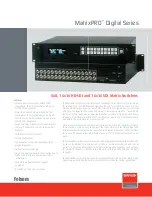
xStack® DGS-3620 Series Managed Switch Web UI Reference Guide
168
1. Linking an area that does not have a physical connection to the backbone.
2. Patching the backbone in case there is a discontinuity in area 0.
All areas of an OSPF network should have a physical connection to the backbone, but in some cases it is not
possible to physically connect a remote area to the backbone. In these cases, a virtual link is configured to connect
the remote area to the backbone. A virtual path is a logical path between two border routers that have a common
area, with one border router connected to the backbone.
Areas Not Physically Connected to Area 0
OSPF also allows virtual links to be configured to connect the parts of the backbone that are discontinuous. This is
the equivalent to linking different area 0s together using a logical path between each area 0. Virtual links can also
be added for redundancy to protect against a router failure. A virtual link is configured between two border routers
that both have a connection to their respective area 0s.
Partitioning the Backbone
Routers that are connected to the same area or segment become neighbors in that area. Neighbors are elected via
the Hello protocol. IP multicast is used to send out Hello packets to other routers on the segment. Routers become
neighbors when they see themselves listed in a Hello packet sent by another router on the same segment. In this
way, two-way communication is guaranteed to be possible between any two neighbor routers.
Neighbors
Any two routers must meet the following conditions before they become neighbors:
1.
Area ID
- Two routers having a common segment
their interfaces have to belong to the same area on that
segment. Of course, the interfaces should belong to the same subnet and have the same subnet mask.
2.
Authentication
- OSPF allows for the configuration of a password for a specific area. Two routers on the
same segment and belonging to the same area must also have the same OSPF password before they can
become neighbors.
3.
Hello and Dead Intervals
- The Hello interval specifies the length of time, in seconds, between the hello
packets that a router sends on an OSPF interface. The dead interval is the number of seconds that a
router
’
s Hello packets have not been seen before its neighbors declare the OSPF router down. OSPF
routers exchange Hello packets on each segment in order to acknowledge each other’s existence on a
segment and to elect a Designated Router on multi-access segments. OSPF requires these intervals to be
exactly the same between any two neighbors. If any of these intervals are different, these routers will not
become neighbors on a particular segment.
4.
Stub Area Flag
- Any two routers also must have the same stub area flag in their Hello packets in order to
become neighbors.
Adjacent routers go beyond the simple Hello exchange and participate in the link-state database exchange process.
OSPF elects one router as the Designated Router (DR) and a second router as the Backup Designated Router
(BDR) on each multi-access segment (the BDR is a backup in case of a DR failure). All other routers on the
segment will then contact the DR for link-state database updates and exchanges. This limits the bandwidth
required for link-state database updates.
Adjacencies
The election of the DR and BDR is accomplished using the Hello protocol. The router with the highest OSPF
priority on a given multi-access segment will become the DR for that segment. In case of a tie, the router with the
highest Router ID wins. The default OSPF priority is 1. A priority of zero indicates a router that cannot be elected as
the DR.
Designated Router Election
Two routers undergo a multi-step process in building the adjacency relationship. The following is a simplified
description of the steps required:
Building Adjacency
•
Down
- No information has been received from any router on the segment.
Summary of Contents for DGS-3620-28PC-SI
Page 1: ......
















































